Fungi in phylogenetic context, history of mycology, hyphae
1/64
There's no tags or description
Looks like no tags are added yet.
Name | Mastery | Learn | Test | Matching | Spaced |
|---|
No study sessions yet.
65 Terms
systematics
identification, taxonomy, and nomenclature of organisms, including their classification of living things with regard to their natural relationships and the study of variation and the evolution of taxa
taxonomy
description, identification, nomenclature, and classification
subset of systematics
what is the hierarchical classification starting from largest
domain, kingdom, phylum, class, order, family, genus, species
dear king phillip came over for good soup
what is the hierarchical classification for fungi (ending letters)
eukarya (domain), fungi/mycota/eumycota/holomycota (kingdom), mycota (subphylum-mycotina)(phylum), mycetes (class), ales (order), aceae (family)
who is the founding father of mycology
micheli. 1729. first to observe the spores of fungi and understand them as reproductive units.
what are the three fundamental domains of life
bacteria, archaea and eukarya (fungi, plants, animals)
definition of fungus
filamentous eukaryotic heterotrophs with apical growth, distinctive cell walls (composed of chitin, glucans, mannans, and sometimes melanin) and typically have haploid nuclei, although hyphae may contain more than one nucleus (dikaryotic condition)
hyphae
fundamental units of fungal ‘bodies’ AKA ‘the mycelium’
units of dispersal
everything in a fungal body. includes: sexual spores, asexual spores, chlamydospores (thick walled spores), sclerotia (& microsclerotia), vegetative propagation, hyphae
mode of growth of hyphae
exploration(extension) from the ends and colonization/capture/resource exploitation from the middle (also where the spores develop and where we find the oldest hyphae). it’s autotropic and self avoidant
autotropic
growing in a straight or vertical line. describes growth pattern.
phagotrophy
a form of nutrition where an organisms engulfs and ingests food particles
osmotrophy
a feeding method where organisms directly absorb dissolved organic molecules from their envr
who is the founding father of classification
carl linnaeus. swedish biologist and physician created the modern system of binomial nomenclature for naming organisms.
robert hooke
one of the first scientists to investigate living things at microscopic scales in 1655 using a compound microscope that he designed. he described and illustrated a hairy mold colony (Mucor)
antonie van leeuwenhoek
father of microbiology. observed yeast budding. 1689
mathieu tillet
won the bordeaux prize for deciphering that a fungal pathogen (later named in his honour, Tilletia) was the cause of ‘stinking bunt’ of wheat. 1750
agostino bassi
demonstrated that a fungus, Beauveria, was the causative agent of ‘muscardine disease’ of silkworms (it decimated the silk industry). 1834
Johann lukas schonlein
demonstrated the first fungal ‘germ’ of humans, linking the skin disease favus to trichophyton. 1839
miles joseph berkely
england’s foremost mycologist, was convinced that phytophthora was the causative agent of the potato blight. he was scorned by the scientific establishment of the time, but he was rights (although it’s an oomycete, not a fungus per se) 1840s
heinrich anton de bary
botanist and physician published seminal works describing the rusts of cereals and developing a classification scheme that was largely in use until the advent of molecular systematics. 1852-66
louis pasteur
noted that heating a fermentation of wine removed bacterial cells, leaving yeast to flourish (pasterization). 1854
albert bernhard frank
described mycorrhization, correctly understanding the syndrome as symbiotic. 1855
alexander flemming
noticed that a staphylococcus aureus he was maintaining had become contaminated with a fungal spore and exhibited inhibited growth. 1928
howard walter florey and ernst boris chain
isolated penicillin and fundamentally changed the practice of medicine. 1940-44
henry arthur reginald buller
first professor of botany and geology at the u of m. 1904
what clade are fungi in
opisthokonts, a broad group of eukaryotes which also includes animals
dikarya
a subkingdom of fungi that includes the divisions ascomycota and basidiomycota
non dikarya fungi
mucuromycota, zoopagomycota, olpidiomycota, blastoclaadiomycota, chytridiomycota, aphelida
telemorph
the sexual reproduction stage (morph), typically a fruiting body
anamorph
an asexual reproductive stage (morph), often mold life. when a single fungus produces multiple morphologically distinct anamorphs, they are called synanamorphs
holomorph
the whole fungus, including all anamorphs and the telemorph
rhizomorphs and mycelial cords
dense interwoven strands of hyphae. mycelial cords are larger but functionally the same as rhizomorphs.
what kind of growth do fungi exhibit
apical dominance (polarized growth) - one direction only which allows it to be autotropic (self avoidant)
what is apical dominance mediated by
spitzenkorper body
spitzenkorper
aggregations of vesicles near the tip of hyphae that directs hyphal growth. integral for germination
where does growth and extension occur
throughout a hypha, whereas extension occurs only at the tip
how does individual hypha grow vs a colony
ind hyphal growth rate is linear, while a colony (the mycelium as a whole) grows exponentially
what are the components in the spitzenkorper
macrovesicles (exterior) and chitosomes (interior)
macrovesicles
secretory, contain enzymes and structural proteins (including mannans)
chitosomes
delivery of inactive chitin synthases which become activated when in contact with the phospholipid bilayer of the cellular membrane
where and how are chitosomes and vesicles transported
transported to hyphal apex by actin microfilaments and microtubules (which are closely associated with mitochondria)
how are vesicles transported to the fungal hyphal tip in ascomycota and basidiomycota.
vesicles move from the golgi apparatus to the spitzenkorper along microtubules, then are carried by actin microfibrils to the plasma membrane
what is the structural building block of chitin in fungal cell walls
n-acetylglucosamine
what happens when glucans are cross linked with chitin
they become alkali insoluble
how do cell wall lytic enzymes contribute to hyphal branching
they lyse (weaken) mature cell walls to allow non apical growth
in fungi grown in liquid culture, what may happen to beta glucans
they can diffuse and form mucilage
melanin in fungal cellular structures
protective structure that protects the hyphae from uv degradation
septum
an internal wall that forms within a fungal hypha
mannoproteins
non filamentous glycoproteins located on the outermost layer of the yeast cell wall
name the layers of the fungal cellular structure starting from the bottom
in the phospholipid bilayer of the cell membrane we have our chitin synthase and our beta 1,3 synthase.
chitin
beta 1,3 glucan then beta 1,6 glucan
and lastly the mannoproteins
septin
type of GTPase, a group of hydrolase enzymes that bind to the nucleotide guanosine triphosphate (GTP). core component of the cytoskeleton.
SepA
specific gene that encodes as essential protein in aspergillus nidulans. it’s a formin type protein (plays crucial role in cytokinesis). governs actin
synchronous mitosis
all nuclei within a hyphal compartment divide at the same time
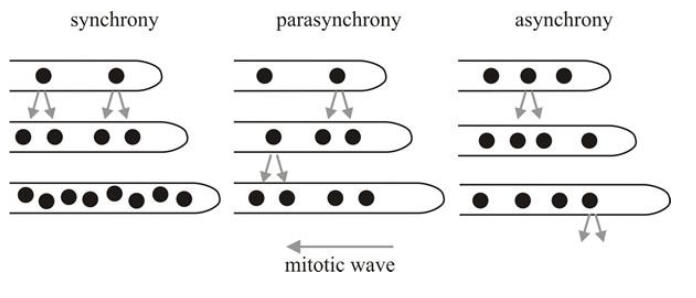
parasynchronous mitosis
mitosis begins with one nucleus and then progresses to adjacent nuclei in a linear fashion. the adjacent nucleus starts to divide after the first one
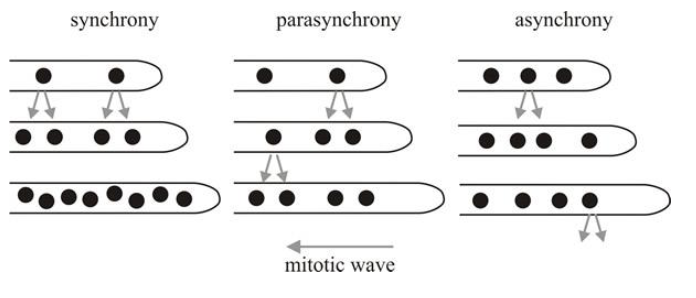
asynchronous mitosis
nuclei divide independently of their neighbours in an uncoordinated manner
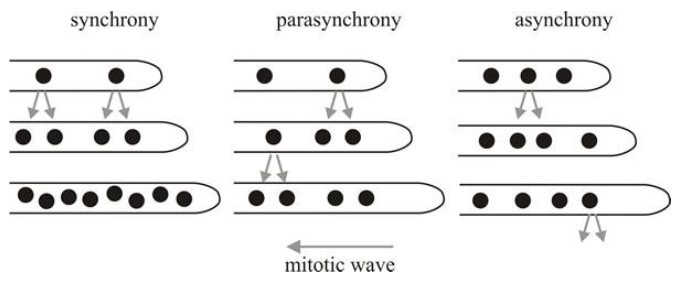
what is a fungal body (mycelium) composed of
hyphae - tubes or filaments with a chitinous cell wall, compartmentalized by septa
what structure governs hyphal extension in fungi
the spitzenkorper
how does fungal mitosis differ from animal mitosis
fungal mitosis is close or semi-open, with the nuclear membrane largely intact. while animals do open mitosis
does fungal mitosis always coordinate with septation
no. mitosis may or may not occur with septation. daughter nuclei may share the same compartment and not all nuclei divide simultaneously
what are key traits of eumycota
mycelium of hyphae with chitin walls
septa compartmentalize hyphae
hyphal growth directed by spitzenkorper
closed/semi open mitosis
nuclei can coexist/divide asynchronously
explain the first step in septum formation
septal band assembly
proteins form a septal band at the site where the septum will be build
actin (red): provides structural framework and helps constrict the membrane
septin AspB (blue): scaffold protein that organizes other proteins
SepA (green): another actin binding protein involved in cytokinesis
at this point, the daughter nuclei have already completed mitosis
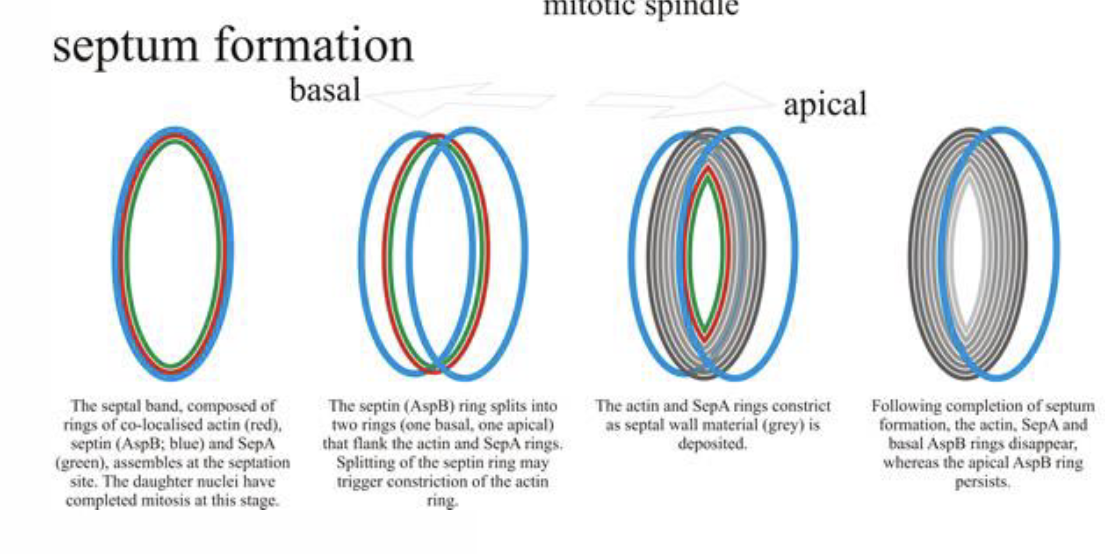
explain step 2 in septum formation
Septin ring splitting
the AspB (blue) septin ring splits into two rings:
one basal (toward the old cell) and one apical (toward the growing tip)
these flank the actin (red) and SepA (green) rings
this splitting may trigger actin ring constriction, starting the process of narrowing the membrane
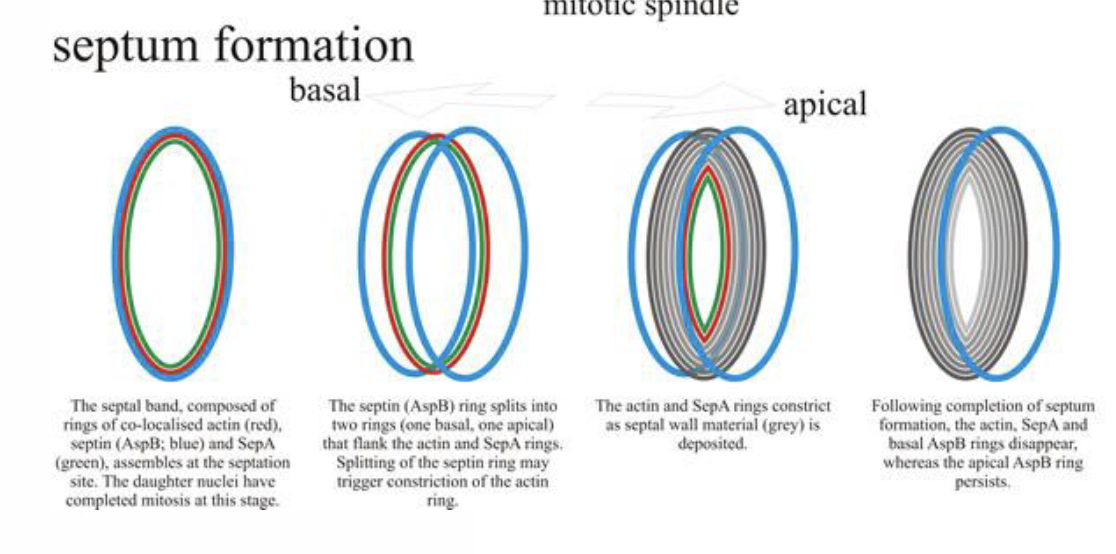
explain step 3 of septum formation
Constriction and septal wall deposition
the actin (red) and SepA (green) rings constrict, pulling the plasma membrane inward
at the same time, cell wall material (grey) is deposited in the growing septum
this builds the septal wall that separates the two daughter compartments
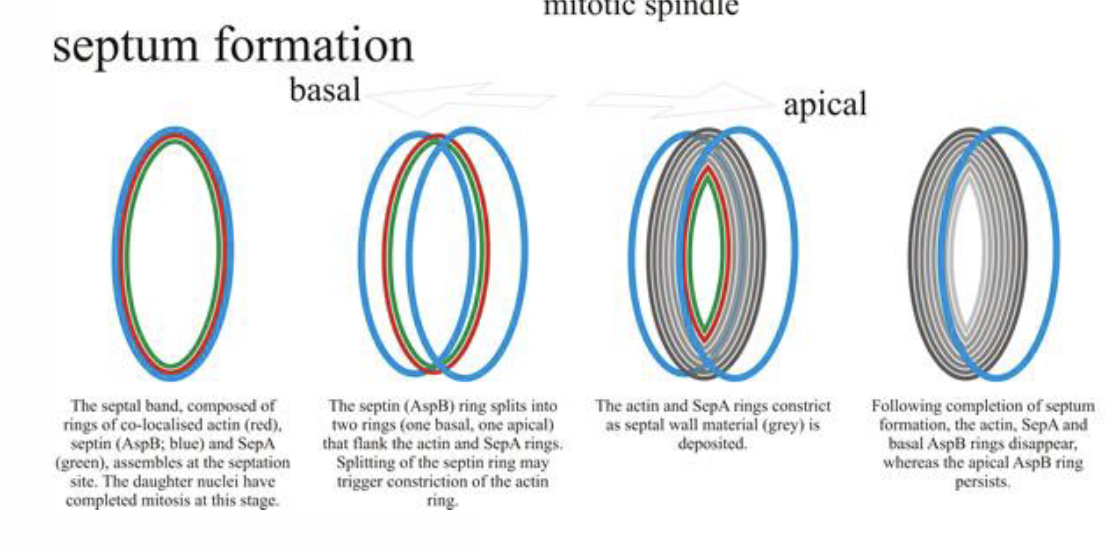
explain step 4 of septum formation
completion
after the septum is fully formed:
actin, SepA, and the basal AspB ring disassemble (they’re no longer needed)
the apical AspB ring (blue) persists, possibly to mark the site or stabilize the new septum